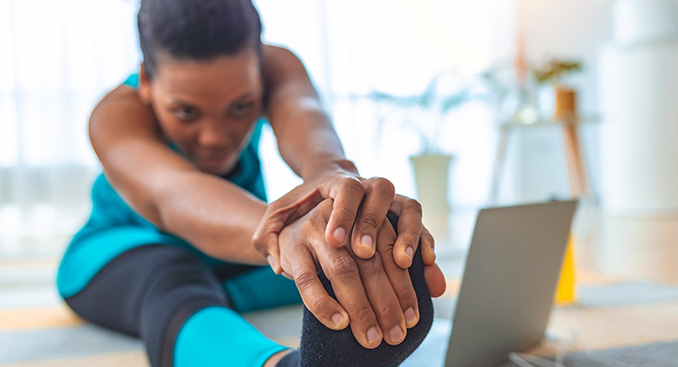6 Exercise Myths Busted

At the beginning of every year, knowing that exercise is critical to good health, millions of people resolve to live a fitter life. Why do so many well- intentioned exercisers fail to persevere? Often, it’s due to mistaken beliefs about how best to get in shape and what it takes to see results. Here, we debunk six common exercise myths.
MYTH #1: “No pain, no gain.”
Most fitness experts agree on the foolishness of this old saying. Pain is an inflammation response that means your body is trying to heal an injury. And yes, to some extent it’s injury—damage to muscle fibers—that causes the soreness you feel the day after you exercise. But soreness is not the measure of a good workout. Instead, judge your success by whether you’ve met your exercise goals.
If you feel less stressed, more fit, more energetic and more flexible, then it’s a quality workout. Post-exercise soreness should be gone in 24 to 48 hours. If it lasts longer, scale back on exercise for now—and see your doctor. And what about pain you feel during the workout itself? It’s your cue to stop that particular exertion. Once you reach “Ouch!” you’ve gone too far.
MYTH #2: “Exercise can help you spot-reduce.”
Men want six-pack abs. Women want thinner thighs. Many people think that by focusing on their problem areas, they can ensure rapid results. They’re wrong. Your body is not able to fine-tune itself that way. It can’t pick and choose where it takes fat from. You need a more holistic approach.
The goal is to burn as many calories as you can—and not just during the workout itself. That means you need to do strength training, which has been shown to speed your metabolism, so you’ll continue to burn calories long after a workout has ended. If you want to change your appearance, you’re better served by training the body as a unit.
MYTH #3: “It’s best to work out early in the morning before you eat.”
Many people start their day with a trip to the gym. Experts say there’s no proven optimal time for exercise, but getting your workout done early in the day, before you get too busy or too tired, is a great habit—just don’t do it on an empty stomach. To burn fat requires intense exertion. If your system hasn’t had fuel since the night before, odds are you won’t have enough ready energy to push your muscles as they need to be pushed. You’ll risk drops in blood pressure and blood sugar—and even dizziness. In short, you won’t have a good workout. Of course, you shouldn’t exercise right after a big breakfast, but do eat something.
MYTH #4: “You must work out every day.”
Some New Year’s exercisers will go to the gym two to three hours daily. At first, they see results. But then they hit a plateau. At that point, they actually regress because they’ve been working too hard, and their results come undone. So they lose interest and stop. One problem is that they’ve failed to give their muscles a rest to rebuild.
Overdoing your workouts can break muscle down as opposed to building it up. And the central nervous system needs time to recover. If it keeps firing the same muscle group relentlessly, those muscles don’t work efficiently. It’s like an engine that runs hot—you can’t keep pushing it at 60 miles an hour all day every day. It’s true that fitness guidelines call for adults to get an hour of physical activity every day. But that doesn’t mean daily workouts at the gym. Map it out so you do different things on different days. Don’t do heavy weight training every day. Do some flexibility or balance training. Add jogging outdoors. Go for a walk. Ride a bike.
MYTH #5: “Lifting weights bulks up women too much.”
To build visible muscle, you need two things: lots of calories and lots of testosterone. Females typically don’t have enough of either. So unless they’re taking testosterone supplements and consuming 3,000 calories a day, women simply cannot build muscle mass the way men can. That’s not to say heavy workouts won’t make a noticeable difference in how you look.
Exercise, particularly cardiovascular training, will help you work off excess fat, which makes the muscles you already have more visible. Strength training will add tone and definition. It will also make you stronger, but being stronger is different than having bigger muscles. And for females, being stronger is what it’s all about. Because they naturally have less muscle and bone mass, women are at greater risk than men for the bone-wasting disease osteoporosis. Resistance training strengthens both muscle and bone, and has been proven to fight osteoporosis.
MYTH #6: “Exercise is a bore.”
This is the myth with a kernel of truth. If you do exactly the same things every time you work out, it can become boring. That’s one reason you should change your routine at least every four to six weeks. Experienced exercisers should change it every day. Even changing the sequence of your exercises or popping new tunes in your music player can fight monotony. But bigger adjustments—adding a new exercise, for instance—can help in another way. By keeping your body off guard, such changes help you avoid plateaus and continue progressing. Our bodies can adapt to almost anything, including an exercise routine.
We need to “surprise” our muscles to keep them from getting too comfortable. So keep your exercise interesting by checking out the machines you haven’t used yet, signing up for a personal training session to get fresh ideas or taking up a new activity.